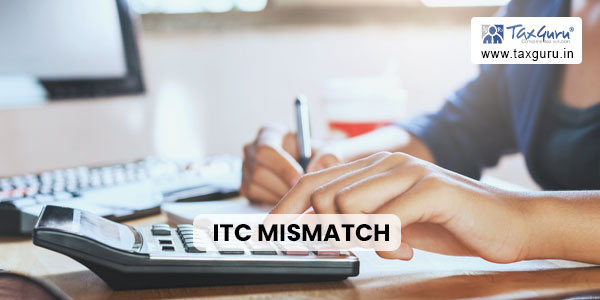While the marquee matching concept of GST – as envisaged in Sections 42 and 43 of the CGST Act, 2017 – did not takeoff, the government has introduced two new rules, Rule 88C and 88D under CGST Rules, 2017. The Rule 88C seeks to match outward supplies and the tax assessed as payable, and the Rule 88D seeks to match the input tax credit availability. Both the rules seek to rely on technology to ascertain mismatches. The GSTN will ascertain the mismatch through data analysis, and the taxpayer will then be required to examine the mismatches conveyed to him electronically on the common portal as well as through email. The taxpayer will have to pay either the differential tax/ITC or explain the differences. While Rule 88C was inserted vide Notification No. 26/2022- Central Tax, dated 26.12.2022, the Rule 88D has been inserted vide Notification No. 38/2023 –Central Tax dated 04.08.2023. This write up focuses on Rule 88D.
The newly inserted Rule 88D reads as follows:
Manner of dealing with difference in input tax credit available in auto-generated statement containing the details of input tax credit and that availed in return.

88D. (1) Where the amount of input tax credit availed by a registered person in the return for a tax period or periods furnished by him in FORM GSTR-3B exceeds the input tax credit available to such person in accordance with the auto-generated statement containing the details of input tax credit in FORM GSTR-2B in respect of the said tax period or periods, as the case may be, by such amount and such percentage, as may be recommended by the Council, the said registered person shall be intimated of such difference in Part A of FORM GST DRC-01C, electronically on the common portal, and a copy of such intimation shall also be sent to his e-mail address provided at the time of registration or as amended from time to time, highlighting the said difference and directing him to—
|
(a) |
pay an amount equal to the excess input tax credit availed in the said FORM GSTR-3B, along with interest payable under section 50, through FORM GST DRC-03, or |
| (b) | explain the reasons for the aforesaid difference in input tax credit on the common portal, |
within a period of seven days.
(2) The registered person referred to sub-rule (1) shall, upon receipt of the intimation referred to in the said sub-rule, either,
|
(a) |
pay an amount equal to the excess input tax credit, as specified in Part A of FORM GST DRC-01C, fully or partially, along with interest payable under section 50, through FORM GST DRC-03 and furnish the details thereof in Part B of FORM GST DRC-01C, electronically on the common portal, or |
| (b) | furnish a reply, electronically on the common portal, incorporating reasons in respect of the amount of excess input tax credit that has still remained to be paid, if any, in Part B of FORM GST DRC-01C, |
within the period specified in the said sub-rule.
(3) Where any amount specified in the intimation referred to in sub-rule (1) remains to be paid within the period specified in the said sub-rule and where no explanation or reason is furnished by the registered person in default or where the explanation or reason furnished by such person is not found to be acceptable by the proper officer, the said amount shall be liable to be demanded in accordance with the provisions of section 73 or section 74, as the case may be.
The Notification No. 38/2023 –Central Tax dated 04.08.2023, under its para 28, has also provided the format of Form DRC-01C. The GSTN has also now enabled the form DRC-01C.
Thus, as per the newly inserted rule and Form-DRC-01C, if the ITC reflected in taxpayer’s GSTR-3B exceeds the ITC reflected in his auto populated Form GSTR-2B, in respect of specific tax period (s), then he will be intimated the details of the same. He will be directed to furnish his reply in the specified format within a specified period of seven days.
The legal background is that as per the Rule 61 (5), as substituted w.e.f 01.01.2021, GSTR-3B as a monthly return under section 39 (1) of the CGST Act (or a quarterly return under proviso to Section 39(1)). It is a return of inward and outward supplies indicating input tax credit availed and tax payable. What is relevant for the instant purpose is that it reflects the ITC self-assessed and availed by the taxpayer. On the other hand, as per Rule 60 (7), the GSTR-2B is an auto drafted statement containing the details of input tax credit made available electronically every month to the taxpayer. It is a static statement made available once every month, and the documents filed by the supplier in Forms GSTR -1, 5 and 6 are reflected in the next open Form GSTR-2B of the recipient irrespective of supplier’s date of filing. Thus, whereas the GSTR-3B is a return that shows the ITC self- assessed and availed by the taxpayer, GSTR-2B is an auto drafted statement showing the documents filed by the suppliers of the taxpayer. The intention seems to verify this gap of self-determined ITC of the taxpayer and the ITC as per the documents filed by his suppliers. Further, as per Rule 36 (4) (b) read with Section 16 (2) (aa), no ITC shall be availed by a registered person (w.e.f 01.01.2022), in respect of invoices or debit notes unless the ITC in respect of these documents have been communicated to him in Form GSTR-2B. Basically the new provisions under Rule 88D/ Form-DRC-01C give a handle to the government to monitor and regulate what was the intent behind Section 16 (2) (aa) .
This newly created arrangement has its pros and cons. The pros are that a system is put in place which will regulate that the ITC is taken as per the provisions of Section 16 (2) (aa); it will help the taxpayer to keep a tab on the input documents which are not as per his GSTR-2B; the taxpayer may also keep a tab on classification of the categories of the mis-match as per the parameters given form DRC-01C; in case of any query by the Department, he can give specific category –wise reply on a readymade template which would also make it easy for tax administration to verify the details and accept the reply . The cons are that the regular digital interface of the government data and taxpayer’s records are a compliance burden on the taxpayer. It is quite a task to regularly match your purchases, imports, previous period’s invoices on which credit was not taken etc. with the data available with the GSTN and explain the discrepancies to the Department. This is a sort of recurrent audit of the specified transactions. Dedicated staff for such purposes may add to the cost of compliance of the taxpayer. Further, it will keep the taxpayer on tenterhooks, as not only demand provisions under section 73 and 74 will be applicable, but immediate specter of blockage of filing of GSTR-1/ IFF for the subsequent tax period will loom over the tax payer under Rule 59(6)(e) of the CGST Rules, 2017.
To conclude, taking of ITC is quite an onerous task. A taxpayer has to be patient and vigilant. It would be advisable for the taxpayer to keep a tab on the mismatches. The taxpayer may keep ready the granular data of the mismatches on the given classification criteria. It would not only be helpful for self-regulation but also for giving a prompt reply (within 7 days) in case some query is raised.
(Disclaimer: The views expressed are the personal views of the author)






Knowledeable